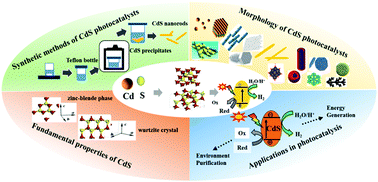CdS-Based photocatalysts
Abstract
To solve the problem of the global energy shortage and the pollution of the environment, in recent years, semiconductor photocatalytic technology that converts solar energy into chemical fuel has been widely studied. Regarding semiconductor-based photocatalysts, CdS has attracted extensive attention due to its relatively narrow bandgap for visible-light response and sufficiently negative potential of the conduction band edge for the reduction of protons. Studies have shown that CdS-based photocatalysts possess excellent photocatalytic performance in terms of solar-fuel generation and environmental purification. This critical review presents the recent advances and progress in the design and synthesis of various CdS and CdS-based photocatalysts. The basic physical and chemical properties of CdS and the related growth mechanism have been briefly summarized. Moreover, the applications of CdS-based photocatalysts have been discussed such as in photocatalytic hydrogen production, reduction of CO2 to hydrocarbon fuels and degradation of pollutants. Finally, a brief perspective on the challenges and future directions for the development of CdS and CdS-based photocatalysts are also presented.



 Please wait while we load your content...
Please wait while we load your content...